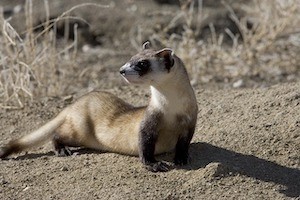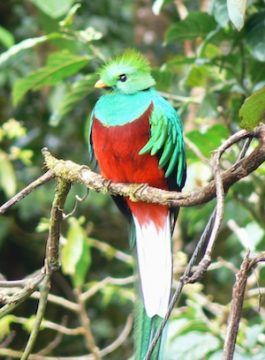by Mary Hrovat
 Nature has filled the world with “endless forms most beautiful and most wonderful,” in the words of Charles Darwin. We humans, faced with this abundance and variety of creatures, have used our imagination to the full in giving them descriptive and often evocative names. Some animal names are fairly straightforward; the name big hairy armadillo lacks nuance, although it makes up in charm what it lacks in subtlety. In other cases, though, we’ve come up with epithets that would make a poet proud: the tawny-crowned greenlet, the sharp-shinned hawk, the pricklenape lizards.
Nature has filled the world with “endless forms most beautiful and most wonderful,” in the words of Charles Darwin. We humans, faced with this abundance and variety of creatures, have used our imagination to the full in giving them descriptive and often evocative names. Some animal names are fairly straightforward; the name big hairy armadillo lacks nuance, although it makes up in charm what it lacks in subtlety. In other cases, though, we’ve come up with epithets that would make a poet proud: the tawny-crowned greenlet, the sharp-shinned hawk, the pricklenape lizards.
Creativity comes into play even in simple descriptions of size and shape. For example, a flat-shelled tortoise is called the pancake tortoise. The least auklet, with its doubly diminutive name, is the smallest auk species, and the smallest owl species is called the elf owl. The Barbados threadsnake (the smallest snake species) is roughly four inches long on average and about as wide as a thick strand of spaghetti. The bumblebee bat is also known as Kitti’s hog-nosed bat, one name reflecting its place as the smallest bat species, and the other describing the shape of its nose. The giant pocket gopher may sound oxymoronic, like jumbo shrimp, until you learn that it’s not somehow a gigantic gopher that fits in a pocket but a large gopher with cheek pouches that it uses to carry food.
The physical characteristics of animals are often described by analogy with other objects. The scimitar babblers are noisy birds with long downward-curving bills, and the scimitar-horned oryx boasts long elegant backward-curving horns. The leaf-nosed bats have unusually developed noses, which they may use for echolocation. The peculiar nose of the star-nosed mole not only gives it a striking appearance but is also highly sensitive. This type of mole has an extraordinarily efficient nervous system, so the sensory data supplied by its distinctive nose are processed quite rapidly.
The pen-tailed treeshrew has a long narrow tail that ends, improbably, in a feather-like plume. (This tiny creature is also noteworthy for consuming large amounts of alcohol, in the form of fermented nectar, without appearing to become intoxicated.) The saw-scaled vipers have a serrated ridge along the center of the scales on their lower sides. When threatened, they coil up in such a way that they can rub these scales together to make a hissing sound. (It seems that, like rattlesnakes, they would rather scare you off than bite you.) The cotton-top tamarin (a New World monkey) has a generous crop of white hair on its head that extends to its shoulders.
Some names include very specific descriptions of Darwin’s endless forms. Animals that use their tails as the camel uses its hump, to store energy in the form of fat, are often referred to simply as fat-tailed (sheep, a gecko, a gerbil), but one is called the turnip-tailed gecko. We also have the fringe-toed lizards, the stump-tailed macaque, and the three-wattled bellbird. The wrynecks (a type of Old World woodpecker) can twist their heads around by almost 180°. The Greek tortoise is named for its Mediterranean home range, but it’s also called the spur-thighed tortoise because of the enlarged scales (spurs) on either side of its tail. The tentacled snake, a small aquatic snake that lives on fish, has two tentacles extending forward from the front of its head.
###
 Animal colors are another rich source of names. The basic colors of a child’s paint set appear in many names and often describe a particular body part, for example, the blue-tongued skinks, the red-bellied parrot, the black-footed ferret, the yellow-throated marten, and the white-lipped deer (which is actually named for a ring of white around its mouth). Some creatures have unexpected colors: the blue wildebeest, the pink pigeon.
Animal colors are another rich source of names. The basic colors of a child’s paint set appear in many names and often describe a particular body part, for example, the blue-tongued skinks, the red-bellied parrot, the black-footed ferret, the yellow-throated marten, and the white-lipped deer (which is actually named for a ring of white around its mouth). Some creatures have unexpected colors: the blue wildebeest, the pink pigeon.
Language often flashes into something like poetry when we describe the colors of animals by comparison and allusion. Consider, for example, the emerald tree boa and emerald tree skink; the ruby-throated bulbul; the saffron toucanet; the dusky indigobird and dusky dolphin; the ashy robin, sooty tern, silvery marmoset, and snowy sheathbill. The cerulean warbler is named for its sky-blue color; the word cerulean may be derived from a diminutive form of the Latin word for sky. The hyacinth macaw, with its gorgeous blue plumage, is apparently named for the hyacinth flower.
The pallid bat has lighter coloring than other bats; the sable antelope ranges in color from chestnut to black. The sulphur-crested cockatoo is named for the bright sulfur yellow of its crest. The crimson topaz is a type of hummingbird with iridescent orange-red plumage, especially in the males. Although there are many birds with “red” in their names, more precise and varied options are also used. Birds are scarlet (for example, a tanager and an ibis), crimson (a sunbird), rufous (an owl and a whistler), vermillion (a flycatcher, of the genus Pyrocephalus, or firehead), ruddy (a pigeon), or rusty (a tinamou). That a kinglet should be golden-crowned seems only appropriate. And then we have the chestnut-eared aracari and the claret-breasted fruit dove. A single color name is not enough to describe the rufous-throated bronze cuckoo. In the context of all this avian brilliance, though, it’s worth pointing out the more understated coloration of the drab myzomela and the plain chachalaca.
Various words are available to describe subtly different types of color patterns—speckled, spotted, marbled, pied, striped, and banded, for example—but more specific variants abound: the side-blotched lizards, the pearl-spotted owlet. Animal patterns are sometimes described in terms of clothing. The collared lizards have distinctive bands at the base of their necks, for example. We also have the spectacled owl, spectacled bear, and spectacled flying fox; the belted kingfisher, the booted eagle, the white-bibbed antbird, the bonneted bats, the bridled tern, and the helmeted iguana. The frill-necked lizard has a large frill of skin at the base of its head, which usually lies back along the neck but can stand up around its head when the lizard is courting or defending itself. Similarly, the male ruffed grouse shows off a striking ruff of black neck feathers in its courtship display.
###
 Although many of the adjectives used in the common names of animals are fairly straightforward, some are unexpected. Some creatures (many of them birds) are so impressive that they inspire high praise: the superb lyrebird and the superb fairywren, the elegant trogon and the elegant sand gecko, the splendid starling, the lovely cotinga, and the resplendent quetzal.
Although many of the adjectives used in the common names of animals are fairly straightforward, some are unexpected. Some creatures (many of them birds) are so impressive that they inspire high praise: the superb lyrebird and the superb fairywren, the elegant trogon and the elegant sand gecko, the splendid starling, the lovely cotinga, and the resplendent quetzal.
The sociable weaver is a type of bird that lives in the southern Kalahari, where entire multigenerational colonies live together in huge compartmented nests that can hold up to 100 pairs of birds and their chicks. (These nests are permanent; some of them have been inhabited for more than 100 years.) There is a silky anteater and a satin bowerbird and a sombre tit. It’s not clear why the sportive lemurs were given their name, but perhaps it has something to do with the fact that they’re agile animals capable of powerful arboreal leaps. The mourning dove and plaintive cuckoo are named for their melancholy cries (although when I was a child I thought it was the morning dove, which seemed right to me because I heard it when I was outside early in the morning).
The common basilisk and the plumed (or green) basilisk are among the more than 50 species of lizards capable of bipedal locomotion (the frilled-neck lizard is another). These two basilisk lizards are also called Jesus Christ lizards for their ability to walk across water—not always very far, and they have to be moving pretty quickly, but still. The sungazer lizard is so called because it regulates its temperature by extending the front part of its body up toward the sky, giving it the appearance of staring sunward.
###
This essay names 99 animals. It can’t possibly do justice to the other features of any of the animals I’ve mentioned, or the evolutionary stories behind their physical characteristics, or the many other fascinating animals in the world and the rich human nomenclature for them. The study of animals (and their names) is an inexhaustible source of joy and interest. However, it’s often shadowed by sorrow as well.
Humans are having a catastrophic effect on Earth’s ecosystems and the other living things with which we share a planet, and a fate. We’re in the midst of a human-caused extinction event of appalling proportions. Is it inevitable that an animal with the mental resources to bestow names with ingenuity and creativity must also possess sufficient drive, ambition, and arrogance to be terribly destructive?
###
The photograph of the collared lizard (Crotaphytus collaris fuscus, a male with female-like coloring) is the work of Patrick Alexander. The image of the black-footed ferret is from PublicDomainImages on Pixabay. The photograph of the male resplendent quetzal is provided copyright-free by D. Hatcher via Wikipedia.
###
You can see more of my work at maryhrovat.com.
